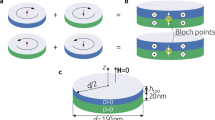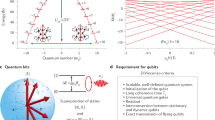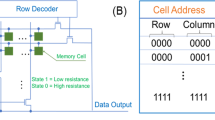Abstract
The single-atom bit represents the ultimate limit of the classical approach to high-density magnetic storage media. So far, the smallest individually addressable bistable magnetic bits have consisted of 3–12 atoms1,2,3. Long magnetic relaxation times have been demonstrated for single lanthanide atoms in molecular magnets4,5,6,7,8,9,10,11,12, for lanthanides diluted in bulk crystals13, and recently for ensembles of holmium (Ho) atoms supported on magnesium oxide (MgO)14. These experiments suggest a path towards data storage at the atomic limit, but the way in which individual magnetic centres are accessed remains unclear. Here we demonstrate the reading and writing of the magnetism of individual Ho atoms on MgO, and show that they independently retain their magnetic information over many hours. We read the Ho states using tunnel magnetoresistance15,16 and write the states with current pulses using a scanning tunnelling microscope. The magnetic origin of the long-lived states is confirmed by single-atom electron spin resonance17 on a nearby iron sensor atom, which also shows that Ho has a large out-of-plane moment of 10.1 ± 0.1 Bohr magnetons on this surface. To demonstrate independent reading and writing, we built an atomic-scale structure with two Ho bits, to which we write the four possible states and which we read out both magnetoresistively and remotely by electron spin resonance. The high magnetic stability combined with electrical reading and writing shows that single-atom magnetic memory is indeed possible.
This is a preview of subscription content, access via your institution
Access options
Access Nature and 54 other Nature Portfolio journals
Get Nature+, our best-value online-access subscription
$29.99 / 30 days
cancel any time
Subscribe to this journal
Receive 51 print issues and online access
$199.00 per year
only $3.90 per issue
Buy this article
- Purchase on Springer Link
- Instant access to full article PDF
Prices may be subject to local taxes which are calculated during checkout



Similar content being viewed by others
References
Loth, S., Baumann, S., Lutz, C. P., Eigler, D. M. & Heinrich, A. J. Bistability in atomic-scale antiferromagnets. Science 335, 196–199 (2012)
Khajetoorians, A. A. et al. Current-driven spin dynamics of artificially constructed quantum magnets. Science 339, 55–59 (2013)
Steinbrecher, M. et al. Absence of a spin-signature from a single Ho adatom as probed by spin-sensitive tunneling. Nat. Commun. 7, 10454 (2016)
Ishikawa, N., Sugita, M., Ishikawa, T., Koshihara, S.-Y. & Kaizu, Y. Lanthanide double-decker complexes functioning as magnets at the single-molecular level. J. Am. Chem. Soc. 125, 8694–8695 (2003)
Bogani, L. & Wernsdorfer, W. Molecular spintronics using single-molecule magnets. Nat. Mater. 7, 179–186 (2008)
Kyatskaya, S. et al. Anchoring of rare-earth-based single-molecule magnets on single-walled carbon nanotubes. J. Am. Chem. Soc. 131, 15143–15151 (2009)
Rinehart, J. D. & Long, J. R. Exploiting single-ion anisotropy in the design of f-element single-molecule magnets. Chem. Sci. 2, 2078–2085 (2011)
Gatteschi, D., Sessoli, R. & Villain, J. Molecular Nanomagnets (Oxford Univ. Press, 2011)
Westerström, R. et al. An endohedral single-molecule magnet with long relaxation times: DySc2N@C80 . J. Am. Chem. Soc. 134, 9840–9843 (2012)
Liddle, S. T. & van Slageren, J. Improving f-element single molecule magnets. Chem. Soc. Rev. 44, 6655–6669 (2015)
Wäckerlin, C. et al. Giant hysteresis of single-molecule magnets adsorbed on a nonmagnetic insulator. Adv. Mater. 28, 5195–5199 (2016)
Layfield, R. A. Organometallic single-molecule magnets. Organometallics 33, 1084–1099 (2014)
Giraud, R., Wernsdorfer, W., Tkachuk, A. M., Mailly, D. & Barbara, B. Nuclear spin driven quantum relaxation in LiY0.998Ho0.002F4 . Phys. Rev. Lett. 87, 057203 (2001)
Donati, F. et al. Magnetic remanence in single atoms. Science 352, 318–321 (2016)
Wiesendanger, R. Spin mapping at the nanoscale and atomic scale. Rev. Mod. Phys. 81, 1495–1550 (2009)
Loth, S., Lutz, C. P. & Heinrich, A. J. Spin-polarized spin excitation spectroscopy. New J. Phys. 12, 125021 (2010)
Baumann, S. et al. Electron paramagnetic resonance of individual atoms on a surface. Science 350, 417–420 (2015)
Gambardella, P. et al. Giant magnetic anisotropy of single cobalt atoms and nanoparticles. Science 300, 1130–1133 (2003)
Khajetoorians, A. A. et al. Spin excitations of individual Fe atoms on Pt(111): impact of the site-dependent giant substrate polarization. Phys. Rev. Lett. 111, 157204 (2013)
Donati, F. et al. Tailoring the magnetism of Co atoms on graphene through substrate hybridization. Phys. Rev. Lett. 113, 177201 (2014)
Baumann, S. et al. Origin of perpendicular magnetic anisotropy and large orbital moment in Fe atoms on MgO. Phys. Rev. Lett. 115, 237202 (2015)
Vincent, R., Klyatskaya, S., Ruben, M., Wernsdorfer, W. & Balestro, F. Electronic read-out of a single nuclear spin using a molecular spin transistor. Nature 488, 357–360 (2012)
Paul, W. et al. Control of the millisecond spin lifetime of an electrically probed atom. Nat. Phys. http://dx.doi.org/10.1038/NPHYS3965 (2016)
Miyamachi, T. et al. Stabilizing the magnetic moment of single holmium atoms by symmetry. Nature 503, 242–246 (2013)
Donati, F. et al. Magnetism of Ho and Er atoms on close-packed metal surfaces. Phys. Rev. Lett. 113, 237201 (2014)
Khajetoorians, A. A. & Heinrich, A. J. Toward single-atom memory. Science 352, 296–297 (2016)
Coffey, D. et al. Antiferromagnetic spin coupling between rare earth adatoms and iron islands probed by spin-polarized tunneling. Sci. Rep. 5, 13709 (2015)
Meservey, R., Paraskevopoulos, D. & Tedrow, P. M. Tunneling measurements of conduction-electron-spin polarization in heavy rare-earth metals. Phys. Rev. B 22, 1331–1337 (1980)
Choi, T. et al. Atomic-scale sensing of the magnetic dipolar field from single atoms. Nat. Nanotechnol. http://dx.doi.org/10.1038/nnano.2017.18 (2017)
Lacroix, C., Mendels, P. & Mila, F. Introduction to Frustrated Magnetism: Materials, Experiments, Theory (Springer, 2011)
Paul, W., Baumann, S., Lutz, C. P. & Heinrich, A. J. Generation of constant-amplitude radio-frequency sweeps at a tunnel junction for spin resonance STM. Rev. Sci. Instrum. 87, 074703 (2016)
Schintke, S. & Schneider, W.-D. Insulators at the ultrathin limit: electronic structure studied by scanning tunnelling microscopy and scanning tunnelling spectroscopy. J. Phys. Condens. Matter 16, R49–R81 (2004)
Pal, J. et al. Morphology of monolayer MgO films on Ag(100): switching from corrugated islands to extended flat terraces. Phys. Rev. Lett. 112, 126102 (2014)
Acknowledgements
We thank B. Melior for technical assistance and F. Donati for discussions. We acknowledge financial support from the Office of Naval Research. F.D.N. appreciates support from the Swiss National Science Foundation under project numbers P300P2_158468 and PZ00P2_167965, and help from A. Natterer. K.Y. acknowledges support from National Natural Science Foundation of China (grant number 61471337). W.P. thanks the Natural Sciences and Engineering Research Council of Canada for fellowship support. P.W. acknowledges financial support from the German academic exchange service. T.G. thanks B. Delley for discussions and IBM Research for its hospitality.
Author information
Authors and Affiliations
Contributions
F.D.N. conceived the experiment and wrote the manuscript. F.D.N., K.Y., W.P. and P.W. analysed the data. W.P. conceived the atom-switching routine. C.P.L. and A.J.H. enabled and supervised the project. All authors carried out measurements, discussed the results and contributed to the manuscript.
Corresponding authors
Ethics declarations
Competing interests
The authors declare no competing financial interests.
Additional information
Reviewer Information Nature thanks N. Lorente, R. Sessoli and W. Wernsdorfer for their contribution to the peer review of this work.
Extended data figures and tables
Extended Data Figure 1 Switching-rate dependence of Ho atoms on MgO/Ag(100).
a, Switching rate at a constant current of 1.5 nA and a total field of 0.495 T (Bz ≈ 50 mT). The three threshold values (listed in c) are identical for positive and negative bias. The light blue circles represent the switching rate that was directly measured from current traces and the dark blue squares show a reduced-duty-cycle measurement for higher switching rates. The black line stems from a piecewise linear fit. b, The current-dependent switching rates follow a power law that has an exponent close to unity for all field and bias conditions. This scaling behaviour indicates a single-electron rate-limiting process in the reversal of the Ho moment by energetic electrons. c, Fit parameters for the switching rate in a. The uncertainties represent the standard deviation in the fit value.
Extended Data Figure 2 Temporal stability of a Ho bit at 4.3 K measured with STM-ESR.
a, ESR spectra for up (top, red) and down (bottom, blue) alignment of the Ho bit at 4.3 K. The sweeps were normalized to the ESR peak height and vertically offset for clarity. b, Monitoring the ESR signal at the two frequencies corresponding to up (blue) and down (orange) alignment of the Ho bit (arrows in a) versus time t (V = 60 mV, I = 20 pA, VRF = 25 mV). The Ho bit spontaneously switches to the up state at t = 1.55 h and remains in that state for the remainder of the sweep. A polynomial background was subtracted from each trace to correct for lateral tip drift. The gap at t = 1.1 h is an interruption that was used to realign the tip onto the Fe sensor to correct for tip drift.
Rights and permissions
About this article
Cite this article
Natterer, F., Yang, K., Paul, W. et al. Reading and writing single-atom magnets. Nature 543, 226–228 (2017). https://doi.org/10.1038/nature21371
Received:
Accepted:
Published:
Issue Date:
DOI: https://doi.org/10.1038/nature21371
This article is cited by
-
Electrically controlled nonvolatile switching of single-atom magnetism in a Dy@C84 single-molecule transistor
Nature Communications (2024)
-
Approaching the uniaxiality of magnetic anisotropy in single-molecule magnets
Science China Chemistry (2023)
-
Towards dielectric relaxation at a single molecule scale
Scientific Reports (2022)
-
Darwinian standard model of physics obtains general relativity
Quantum Information Processing (2022)
-
Engineering atomic-scale magnetic fields by dysprosium single atom magnets
Nature Communications (2021)
Comments
By submitting a comment you agree to abide by our Terms and Community Guidelines. If you find something abusive or that does not comply with our terms or guidelines please flag it as inappropriate.



